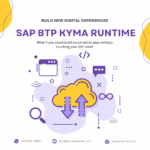The Why: Bridging the Gap Between Technology and People
In today’s fast-evolving business world, technology is omnipresent—but having technology isn’t enough. At its core, a truly successful enterprise isn’t defined solely by its IT investments; it’s defined by the way that technology serves the people who use it. Consider this: why do many companies still struggle with clunky, outdated interfaces and cumbersome workflows? Because, too often, technology is developed with functionality in mind but not with the human experience at heart.
The answer lies in a fundamental shift—a shift from “just another system” to tools that empower, inspire, and enable. This is where SAP Fiori comes into play. SAP Fiori isn’t just about a new look for legacy applications; it’s about rethinking the user experience so that every interaction is intuitive, efficient, and truly human-centered.
The Problem: Frustration with Traditional Enterprise Interfaces
Many organizations rely on traditional ERP systems that, while powerful, often come with interfaces that feel like relics from another era. Users face challenges like:
- Complex Navigation: Employees must click through numerous screens and layers of menus to perform simple tasks.
- Inconsistent Experiences: Different modules offer vastly different user interfaces, leading to confusion and inefficiency.
- Steep Learning Curves: New hires and even seasoned employees struggle with training, wasting valuable time.
- Low User Adoption: When systems are difficult to use, people either avoid them or revert to workarounds, diminishing overall productivity.
These challenges don’t just frustrate users—they create real business obstacles. Poor user experiences can lead to errors, delays, and missed opportunities, ultimately affecting customer satisfaction and company performance. In essence, the technology that is supposed to empower the workforce instead becomes a barrier.
What is SAP Fiori?
SAP Fiori is a paradigm shift in enterprise software design. It represents a new approach to user experience (UX) that puts people first. At its core, SAP Fiori is a collection of design principles and a user interface (UI) framework that transforms how users interact with SAP applications.
Key Aspects of SAP Fiori
- Intuitive Design: SAP Fiori uses a clean, simple, and modern design that mimics the ease of use found in consumer apps. The goal is to make enterprise software as engaging and straightforward as everyday apps.
- Role-Based Experiences: Instead of overwhelming users with every possible function, SAP Fiori tailors interfaces to specific roles. A finance manager, for instance, sees tools and data that are relevant to financial operations, while a supply chain specialist sees a different set of information.
- Responsive and Adaptive: Whether on a desktop, tablet, or smartphone, SAP Fiori’s design adapts to the device. This means users can work on the go without sacrificing functionality or usability.
- Consistent and Cohesive: Fiori provides a consistent experience across all SAP applications. This uniformity reduces the learning curve and builds confidence among users.
The Power of Design: Why It Matters
Design isn’t just about aesthetics—it’s about functionality and efficiency. When technology is built around human behavior, it naturally becomes more powerful. Here are some key ways that design impacts business:
Increased Productivity
When systems are easy to use, employees spend less time wrestling with software and more time focusing on their core responsibilities. A well-designed interface minimizes errors, reduces training time, and speeds up task completion.
Enhanced User Engagement
A modern, visually appealing interface makes work feel less like a chore and more like a seamless part of the daily experience. When employees enjoy using their tools, they’re more likely to embrace new processes and adopt innovative practices.
Better Decision-Making
User-friendly interfaces ensure that data is not only accessible but also understandable. When information is presented clearly, decision-makers can quickly grasp insights and act on them, leading to smarter, more informed decisions.
Reduced Operational Costs
By minimizing the time and effort required to complete tasks, businesses can lower operational costs. Fewer errors mean fewer costly corrections, and streamlined workflows lead to significant time savings across departments.
How SAP Fiori Solves the Problem
SAP Fiori addresses the limitations of traditional enterprise software by putting user experience at the forefront. Let’s break down how it does this:
1. Role-Based, Task-Oriented Design
Instead of forcing every user to navigate a one-size-fits-all interface, SAP Fiori provides role-based applications. This means that every user sees only what they need—nothing more, nothing less. For example:
- Finance Professionals get dashboards that display real-time financial metrics, approvals, and reporting tools in one consolidated view.
- Procurement Teams access streamlined workflows that simplify order processing, supplier management, and invoice verification.
- HR Specialists are provided with intuitive interfaces for managing employee records, benefits, and performance reviews.
This targeted approach ensures that users can complete tasks efficiently, without unnecessary distractions.
2. Simplified Navigation and Intuitive Interactions
SAP Fiori employs a flat, minimalist design that eliminates excessive menu structures. Instead of multiple nested layers, users have a clear, linear path to complete their tasks. Buttons, icons, and action items are clearly defined and follow common usage patterns, reducing the cognitive load on users.
3. Real-Time Responsiveness Across Devices
In today’s fast-paced world, employees need access to data and applications anytime, anywhere. SAP Fiori’s responsive design means that whether you’re in the office, on the road, or working remotely, your user experience remains consistent and reliable. This mobile-first approach is crucial for organizations with a geographically dispersed workforce.
4. Integration with Intelligent Technologies
SAP Fiori is more than just a frontend redesign. It’s integrated with the broader SAP ecosystem, which includes advanced analytics, AI, and machine learning. For instance:
- Predictive Analytics: Dashboards can incorporate real-time data analytics to help users foresee trends and make proactive decisions.
- Voice-Activated Commands: Future iterations of SAP Fiori are exploring natural language interfaces, enabling users to interact with systems via voice commands.
- Automation: Routine tasks can be automated, reducing manual work and freeing up time for strategic initiatives.
5. Continuous Improvement Through User Feedback
One of the core philosophies of SAP Fiori is to evolve continuously. User feedback is not an afterthought—it’s central to the design process. SAP actively gathers input from real users to refine and improve the interface, ensuring that the system remains aligned with the needs of the workforce.
Real-World Impact: Transforming the Enterprise Experience
To truly understand the impact of SAP Fiori, consider some real-world examples:
Case Study: A Global Manufacturing Company
A multinational manufacturing firm was struggling with outdated, clunky ERP interfaces that slowed down production and led to frequent errors in order processing. After implementing SAP Fiori:
- Efficiency Improved: Employees reported a 40% reduction in time spent on routine tasks.
- Error Rates Dropped: Improved data visibility and intuitive workflows reduced order errors by 30%.
- Employee Satisfaction Increased: Users found the new interface refreshing and easier to learn, leading to higher adoption rates and less resistance to change.
Case Study: A Leading Financial Institution
A prominent bank was facing challenges with disparate systems used across various departments. The introduction of SAP Fiori unified these systems, enabling:
- Streamlined Workflows: Custom, role-based dashboards allowed each department to access relevant data without navigating through unnecessary information.
- Faster Decision-Making: Real-time insights helped executives respond quickly to market changes.
- Cost Savings: Reduced training time and fewer errors resulted in significant operational savings.
Case Study: A Retail Chain’s Digital Transformation
A major retail chain leveraged SAP Fiori to revamp its customer service and inventory management systems. The result was a more agile operation that could:
- Predict Demand Accurately: Data-driven insights allowed for better stock management.
- Enhance Customer Experience: A unified interface provided consistent and quick responses to customer queries.
- Boost Sales: Improved operational efficiency directly contributed to increased sales and customer loyalty.
The Human Element: Empowering Every Employee
At the heart of SAP Fiori’s success is its focus on the human element. It’s not just about making software prettier—it’s about making technology work for people. When systems are easy to use, employees can focus on what truly matters: innovation, creativity, and strategic thinking.
Imagine a scenario where a salesperson can access real-time customer data on their tablet during a meeting, or where a supply chain manager can instantly view and act upon live inventory updates from a mobile device. These are not mere conveniences; they are strategic advantages that drive better business outcomes.
The Broader Implications for Digital Transformation
The shift to user-centric design is more than a trend—it’s a fundamental change in how organizations view technology. When businesses embrace solutions like SAP Fiori, they signal a commitment to:
- Agility: The ability to adapt quickly to market changes.
- Empowerment: Giving employees the tools they need to succeed.
- Innovation: Creating a culture where continuous improvement is the norm.
- Customer-Centricity: Ensuring that every interaction, both internal and external, is streamlined and meaningful.
This holistic approach to digital transformation is what separates truly intelligent businesses from those that merely pay lip service to innovation.
The Road Ahead: Embracing a New Era of Enterprise Experience
The journey toward a fully integrated, intelligent enterprise is ongoing. As technology evolves, so too will the expectations of users. Future developments in SAP Fiori may include even more advanced features such as augmented reality interfaces, deeper integration with IoT devices, and increasingly sophisticated AI capabilities.
But one thing remains constant: the need for a system that not only keeps up with technological advancements but also puts people at the center of every decision. SAP Fiori is not the end of the road—it’s the beginning of a new era where technology and humanity coexist in perfect harmony.
Final Thought: Technology Should Serve People
Ultimately, the most successful enterprises are those that recognize technology is a means to an end, not the end itself. SAP Fiori is a powerful example of this philosophy. By prioritizing the user experience and fostering a culture of innovation, businesses can overcome the challenges of outdated systems and transform their operations from the inside out.
The future of work is here, and it’s about more than just data and automation. It’s about creating an environment where every employee feels empowered, every process is seamless, and every decision is driven by clear, actionable insights.
Are you ready to reimagine your enterprise experience? Embrace SAP Fiori and let your technology work for you, not against you.











